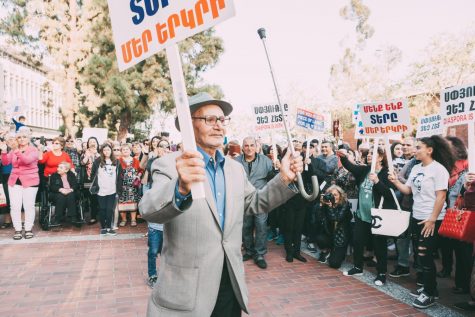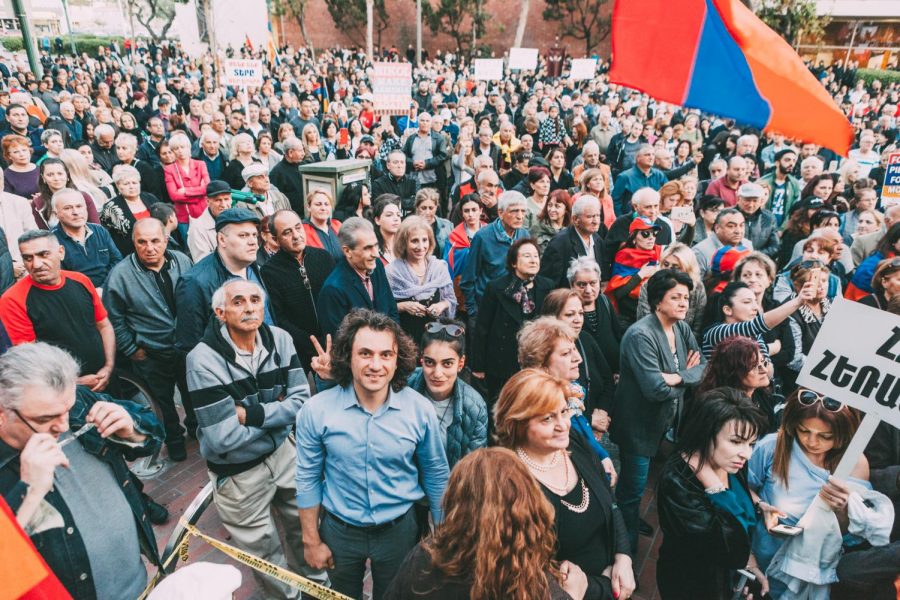THE ARMENIAN PROBLEM
Peaceful protests lead to the resignation of an authoritarian leader
Yeghishe Charents, an Armenian poet once said, “O, Armenian people, you only hope for salvation is in your unity.” Armenian communities have taken these words into consideration, realizing how true they can be.
When Armenia gained its independence from the Soviet Union in 1991, the people had no idea what was to come and what the country was going to fall into. The close-knit, landlocked nation of 2.9 million current residents, has suffered from poor leadership and overpowering corruption.
Being relatively new to the concept of democracy, Armenians didn’t make the best choice for its incoming leadership by voting a president into office who took the first step in leading a totalitarian government. With only three presidents in its history, the Armenian National Congress, never really had a president from a political party other than that of the Republican Party of Armenia. The two most recent presidents each led a presidency of two terms, five years each.
Many protests and uprisings took place during the time of the previous two administrations. In that time, the protests on the streets never led to a solution for the never-ending problems in Armenia. There was simply too much corruption taking place in the country. During these years, the Armenian economy also took a deep dive, leaving about 29.8 percent of the population in poverty, according to statistics from the Asian Development Bank. The cost of living has risen each year, while, at the same time, an average person earns no more than $400 per month in the country. Many Armenians have made their way to the U.S. and Europe as a result of the poor economic conditions.
It is also noteworthy to say that the Armenian economy has become heavily dependent on tourism, mainly from Armenians from the Diaspora, Europeans and Asians.
In 2015, Serzh Sargsyan, the most recent president of the country, altered the constitution. He was nearing the end of his second term and wanted to grant the prime minister the ultimate power of the country by taking that away from future presidents. Formerly, he was defense minister and then went on to become president. He served for two terms of five years each and then became prime minister. He practically appointed himself.
The only logical reasoning behind his bold move was to simply keep himself and the RPA in power indefinitely.
This bold step caused quite the stir within residents of Armenia and the those abroad, raising a concern of authoritarian rule descending on the country. To refrain from any kind of conflict, Sargsyan publicly announced that he had no interest in obtaining the position of prime minister upon the completion of his second term as president.
On April 13, sensing the upcoming letdown of the people, opposition leaders called this a “power grab,” and invited Armenians to join the movement. Thousands and thousands did.
That day peaceful protests took a big step as large crowds joined hand-in-hand with each other to fight for a country free of corruption and dictatorship. The protests took their peak, when an estimated 120,000 Armenians took to the streets of Yerevan, the capital of Armenia.
Opposition leader, Nikol Pashinyan, took the lead of the movement and showed his dedication to the people, when he completed a 14-day walking strike around the country. He hoped to deliver the plan and news to remote regions, and encourage the people from these cities to join as well. And they did.
As the days went by, tens of thousands of people gathered all over the country, engaging in acts of civil disobedience. Some of the biggest moves that the protesters made included blocking major roads and highways connecting Armenia to neighboring countries, such as Iran and Georgia.
The streets of Yerevan became filled with hope as dissidents waved their tricolor flag more proud than ever. A change was coming. As the peaceful demonstrations continued, it became evident that the prime minister of the people would be the one and only, Pashinyan.
To help raise awareness about the Armenian problem, and support their brothers and sisters in Armenia, the Diaspora, too, joined the movement. Thousands of people gathered in the streets of major cities worldwide, holding some of the most inspiring and hopeful community rallies. Armenians residing in cities such as Paris, Moscow, Bielefeld, Sydney and Los Angeles organized rallies. The point was one – to support.
Being home to the biggest Armenian population outside of Armenia, Los Angeles showed its full support when the ethnic group came together to rally in support of their countrymen.
Stairs of the Glendale City Hall became all too comfortable for the young activists who organized the event, as they concurrently, with their counterparts in Armenia, gathered to express their concerns against the Armenian government.

Activist come in all ages and forms, a prove of which is an enthusiastic attendee of the rallies in Glendale.
Meanwhile in Armenia, activists, young and old, continued to fight for their constitutional rights.
On April 23, people woke up teary eyed, congratulating one another. Sargsyan had resigned, claiming that he no longer wanted to continue the fight with the people.
“Nikol Pashinyan was right. I was wrong,” he said. “The situation has several solutions, but I will not take any of them. The street movement is against my tenure, I am fulfilling your demand.”
Just 10 days before Sargsyan’s resignation, Pashinyan declared “Velvet Revolution,” claiming that this was going to be just the beginning of the new Armenia. The term “Velvet Revolution” first came about in 1989, describing the smooth, non-violent and bloodless transition of power of then Czechoslovakia from Communist rule. Same thing happened in Armenia.
Many Armenians abroad have already started to return to the fatherland, taking their businesses to invest in a future at home.
Though in Armenia, the police and armed forces used tear gas and physical beating techniques to disperse the crowds, there was absolutely no violence coming from the people.
After the resignation of the 63-year-old autocrat, many politicians, police officers and government workers, left their jobs to join the people. And though it seems that the main part of the issue has been resolved, one can agree that it is just the beginning of the big Armenian revolution.
Unity, resiliency and faith brought Armenians to a point of success, becoming the first of its kind in the Caucasus region to lead a peaceful revolution.
After a day of debate in parliament Tuesday, the Armenian National Assembly voted 45 to 57, to reject Pashinyan’s election as prime minister. It is noteworthy to mention that the opposition leader was the only candidate running for the position.
As the Armenian constitution states, a new election will be organized in a week. In the case of failure to elect a new prime minister next week, public elections will be held, where citizens of the country will get to vote.
Knowing that he is the people’s choice of Prime Minister, Pashinyan encouraged the demonstrators to continue to march and rally, whether they’re in their homeland or abroad.
Marian Sahakyan can be reached at [email protected]

Growing up in a big family of journalists and writers, Marian developed her love for writing and reporting since early childhood. She is often found in...

